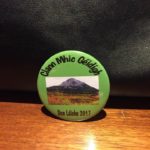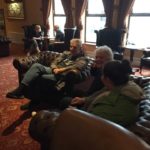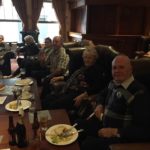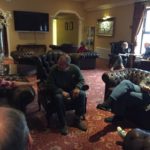Mauch Chunk in 1840
Paul J. McGeady, 1991
Mauch Chunk is situated at a bend in the Lehigh River about 90 miles northwest of Philadelphia. It was a frontier town carved out of a wilderness inhabited by Indian tribes. The name, Mauch Chunk, is Indian and means, “Bear Mountain”—a name bestowed on the bear-like shaped mountain on the opposite side of the river from the settlement.
The village or town or community of Mauch Chunk’s later remarkable relative prosperity came from that magic word Gold—in this case Black Gold or Black Stones, which we now call anthracite coal. Here was discovered the source of fuel for the American Industrial Revolution.
It all started by accident. A few miles from Mauch Chunk, a trapper, Philip Ginder, in 1791 built his usual campfire on a mountain later known as Summit Hill. The fire he started on some black stones refused to go out. The stones, as if by a miracle, were “burning.” Ginder [took] his Black Gold or Black Diamonds and reported his “find” when he returned to civilization.
The rush was on! Entrepreneurs, laborers, craftsmen and capitalists quickly descended on the area. They needed homes, food and essentials, and quickly, by Yankee and European ingenuity, a village full-blown was carved out of this mountainous wooded area in the bend of the river.
Roads had to be built to get at the source of the coal mine miles away and get it to the river. It was not until 1820 that the first real pay load was floated down the Lehigh on its way to Philadelphia. By 1825, 28,000 tons had been shipped. Now the race was on to exploit this marvelous find which brought prosperity for some, back-breaking labor for others and national and local strife and controversy. But at that moment—”It’s there!” “If we can get it to the river” we can send it East where the demand is limitless. Oddly enough, the practice was to dismantle the coal boats when they arrived in Philadelphia and return only with the hardware (nails, hinges, and metal straps).
As usual, those who had capital and political influence reaped the greatest advantage. It has been said that thirteen million dollar fortunes were made in those early days at Mauch Chunk.
These were exciting times. Corporations were formed. Houses were built in essentially a one-street ravine. When more houses were needed, they were built on the side of the ravine connected to the main street. Finally Josiah White, an entrepreneur from Mount Holly, New Jersey, decided the only practical, cost- efficient way to market the coal was to build a railway (only the second one in America).
It was begun in the winter of 1826-27 by the newly formed Lehigh Coal and Navigation Company started by Josiah White. It was built over the mine road north of the ravine. It descended the nine miles from the mine by gravity, with a brakeman holding the 14 cars to 6 miles per hour for the descent of 726 feet. When the cars reached the river, they were let down an inclined plane to boats waiting below and then off to the eastern markets.
The exciting pace continued—more anthracite, more men, more homes, more investment, engineers, builders, boats, stores, families. It was to this bustling energetic environment that Michael McGeady arrived. What a far cry from Donegal! But the mountains looked familiar and Michael said, “It is here I’ll live and make my fortune and some day marry.” He was 16 years of age when he arrived in 1836 to start his life in the New World. He was remarkably successful.














